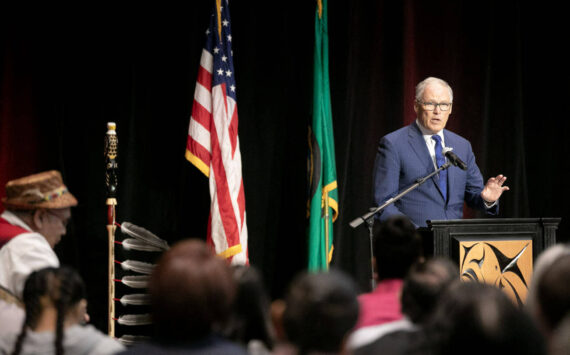Seven points of tension – and productivity
By Morf Morford
Tacoma Daily Index
To put it mildly, leadership in the 21st Century is a challenge.
Dynamics and principles of leadership have always been in flux, but the possibilities, the challenges and yes, even the stakes, are vastly higher now than ever before.
The pace of change is relentless and unforgiving.
Comparisons of previous eras, reigns and kingdoms emerge in daily conversations and headlines on a regular basis.
As anyone who studies history even a little would know, history repeats itself continually, though never exactly.
The stress factors of each era, and the difficulties each nation, community, business and individual faces will always be different.
History, as with any individual life, is only fully known in retrospect – if ever.
The challenges we can identify are difficult enough – the challenges we have yet to see are the ones we must be prepared for.
As George Orwell put it in his ever-prescient novel 1984, “Who controls the past controls the future. Who controls the present controls the past.”
Making sense of the present is crucial, but it is also the ultimate fool’s errand.
It may never be fully correct and is likely to hold some error-blindness stunningly obvious to those a few years ahead, but, in spite of its impossibility and built-in multiple margins-of-error, is essential – if not crucial – for setting a course for the future – for sustainability if not prosperity.
Harvard Business Review (HBR) is one of those journals that tends to be on the trend line for the converging issues that are forming on our business horizon.
In a recent article (https://hbr.org/2020/02/every-leader-needs-to-navigate-these-7-tensions?) HBR clarifies seven tensions, seven dynamics seemingly in opposition, but crucially interdependent, perhaps not unique, but certainly dominant – if not overwhelming – in today’s economic environment.
Here’s a brief overview of what the authors see as the seven stressor points of tension facing us in an economy roiled by, and perhaps eventually dominated by concepts alien to economists (if not all of us) just a few years ago, like the sharing economy, gig employment or the freemium business model.
Picture each set as a pair of massive beasts tied together, back to back, each seeing and determined to reach something only it can see, each one capable of solving any problem – or creating untold havoc if unrestrained.
Each aspect adds power and potential beyond description and each one leads its own style of repercussion and reaction in its wake.
Tension 1: The Expert vs. the Learner
It has always been true that no one is an expert in everything. What has not always been true is the inherent, if not borderline immediacy of the evanescence of knowledge.
What was true a few years ago, perhaps even for millennia, is not necessarily true, or even relevant today – or, even more so, tomorrow.
Technology, privacy, copyright rules, even gender or ethnic identity is not as firm as it was in the previous, or maybe even any, business cycle.
Yesterday’s “expert” is today’s fool and today’s hottest trend is tomorrow’s punch line.
If we are not prepared for the convolutions of virtually every aspect of the market, we can expect to be pummeled by every twist and turn, but if we are willing (or able) to hold our knowledge loosely, we just might be able to swim, or at least float while others flounder – or worse.
Prepare to be a learner if you want to flourish in the 21st Century.
Tension 2: The Constant vs. the Adaptor
Standing by principle is great if not essential – as is flexing to a constantly changing landscape.
Knowing when to hold or when to adapt is the ultimate transferrable skill in life and business. Fortunes (and relationships) have been founded or lost on the ability (or refusal) to adapt to ever-shifting circumstances.
Don’t abandon your principles, but also do not forget that they too exist to strengthen and solidify, not suffocate.


Tension 3: The Tactician vs. the Visionary
The visionary sees what is not yet visible to most. The tactician is the one who charts the journey there.
Both are essential.
The visionary in your organization (or family) may seem like the one who is always “lost” – but after all is said and done, was probably the only one who really knew where the organization was really going.
The tactician fills in the colors on the sketches of the visionary.
These are very different personalities, temperaments and skill sets, and every organization is made stronger from both of them.
And without both of them, any organization is lost.
Tension 4: The Teller vs. the Listener
Any leader, from department head to presidential candidate, needs a good story, some way of explaining the identity and purpose of the organization – and each individual’s place in it.
A follower, or an engaged employee, is above all a good listener – and a good listener is not a blind follower. The best listener is the one who tests, who leans on, who even might question the teller – but who always makes the story stronger and more compelling.
Tension 5: Power Holder vs. Power Sharer
In politics and business, no one holds power forever. Making room for, in fact even cultivating the next generation of leadership is essential.
Every organization is greater than its leader – even its best leader.
And its best leader will always be preparing for that next step, that next opportunity or even that next catastrophe.
For better or worse, there will always be something “next” on the horizon.
Tension 6: The Intuitionist vs. the Analyst
If there were ever an eternal question in any organization it would be, do we follow the data or our intuition?
Do we use our (usually hard-earned) life experience, our second sense about things, or do we trust the data?
The problem is that one is one is inherently verifiable, while the other is forever beyond documentation.
The intuitive mind “knows” things but may not always be able to convey them.
The analyst may not necessarily “know” anything, but can (usually) clearly see the data – and understand what it means.
Data, we sometimes forget, is subject to interpretation – and is very much situational. Would this same data set be true in another time and place? And would another set of eyes come to the same conclusion based on the same data?
Data needs to be understood and applied tactfully, it can be an elegant tool, or a terrible weapon.
Both intuition and data have led organizations (and individuals) astray. And both have led organizations (and individuals) into new and unparalleled opportunity.
Tension 7: The Perfectionist vs. the Accelerator
The “perfect” is often achieved at the cost of the entire project.
Defining “good enough” might be the biggest challenge of all.
Perfectionism, after all, leads to paralysis as often as not.
“Good enough” and discerning when it is – or is not – truly “good enough” is the most difficult move in the ever changing ballet of business.
As with all the other areas of tension, there are few, if any final answers.
Success is never finished and rarely certain while failure, to some degree, is always possible, but is also never final.








